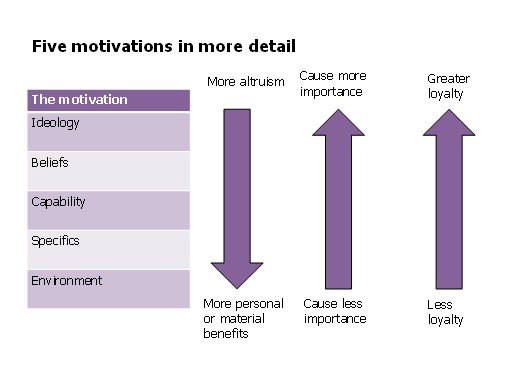One of the things that always fascinates me about US elections is how people make a donation to candidates who stand little chance of winning. To give an example, Beto O’Rourke, who ran against Ted Cruz in Texas was given just a 2 in 9 chance of winning by the respected US consultancy Five Thirty Eight. Yet he raised a total of $78 million dollars with the typical donation being under $200.
The amazing thing is that all those hundreds of thousands of donors have seen their money wasted – their candidate wasn’t elected. Imagine if a UK charity said give us a donation but there was a 7 in 9 it would be wasted. This would go against all the rules. The impact gurus at NPC would be tearing their hair out.
However giving to potentially un-successful causes and candidates makes perfect sense if your motive is a shared vision of how you want the world to be, rather than the impact of your donation today. Nobody expects a vision to come about all at once. Under a model of motivation based on some of the ideas behind neuro-linguistic programming (NLP)[1] there are five types of motivation:
- Vision/ideology. This organisation shares a supporter’s view of the world and how it works or should work – in short, the supporter is motivated by the organisation’s vision or ideology. The organisation could be a charity (like Greenpeace) or a political party or a religious organisation.
- Values/beliefs. The supporter shares a charity’s beliefs about a right or wrong in the world and how to solve it. This might be a specific issue like the treatment of refugees or a set of beliefs such as human rights.
- Capabilities. This charity has shown they have the capability to do good and a supporter gives to them for that reason. A good example might be a belief that they can provide services in a disaster or emergency, or they can tackle a specific issue like homelessness.
- Behaviour/specifics. This charity does a specific, achievable good thing that a supporter wants to happen, and that supporter often also gets something in return. This motive tends have more personal benefits for the supporter and would cover child sponsorship, National Trust membership or buying charity lottery tickets.
- Environment. This charity benefits the supporter, their life or their immediate world. It could cover fundraising or volunteering for a PTA where somebody’s children are at school, or team fundraising in an office for a telethon.
Most charities will hopefully recognise some of these motivations in their own communications and fundraising activities. Each has strengths and weaknesses in its key characteristics and the chart below shows how loyalty, the importance of the cause, and the need for benefits changes across the five motivations.
The motivations at the top end of the chart tend to have more altruistic motives – people care less whether they get a benefit, or even whether they know if the donation has made a difference. A legacy donation would be the perfect example of this: somebody is dead by the time the donation is put to work. Towards the bottom of the hierarchy personal benefits are very important. Parents only fundraise for schools where their children are – not where they aren’t. People fundraise for a telethon at work partly because it’s a good sociable, team-building activity. People join the National Trust because they get free entry to properties.

This means that the ‘cause’ is more important in the ideology and values/beliefs motivations, whereas ‘benefits’ are more important in environment or specifics motivations and the cause is less important. Many runners take part in fundraising events because they love doing things with their friends, or want to take part in a race like the London Marathon or Great North Run and the charity they run for is secondary (though many also do it because they care deeply about the cause).
I would hate anybody to think I am suggesting that some of the motivations are better than others. The important thing is that the five motivations have different characteristics: they are more like different types of car and work in different ways.
A charity needs to understand those characteristics in order to maximise the numbers who engage because of each type of motivation. So anybody who gives because they share a ’vision’ needs to hear and feel the aspirational language, the lofty goals, the strong ideals, the articulations of rights and wrongs. Anybody who is giving because of the ‘environment’ or ‘specifics’ motivations needs to hear about how the organisation will give them the benefits they are after: prizes in the lottery, learning about the life of an overseas child to educate their children or buy equipment for their children’s school.
There is no one motivation that is right or wrong, however an organisation should try and use a broad spectrum. It is like investing in a diverse portfolio of investments. Different motivations appeal to different kinds of people by demographic and attitude; indeed different types of fundraising match the different types of motivations. Fundraising events tend to be more about specific and environment motivations. Direct debits more about capabilities and beliefs/values. Those organisations with a less popular cause should therefore look at motivations where cause matters less.
One final point – demonstrating impact is not equally important in all of these motivations. It is relatively unimportant in vision (which is why people gave to Beto O’Rourke even though he was odds on to lose) and in environment or specific motivations it is also less important (put crudely if you could win a lottery prize or get free entry to properties, why care about impact?). However in capability demonstrating impact is probably the most important factor– if somebody is giving because they hear the news about a natural disaster or want to help rough sleepers or help sick people, then they have every reason to want to know that it works.

